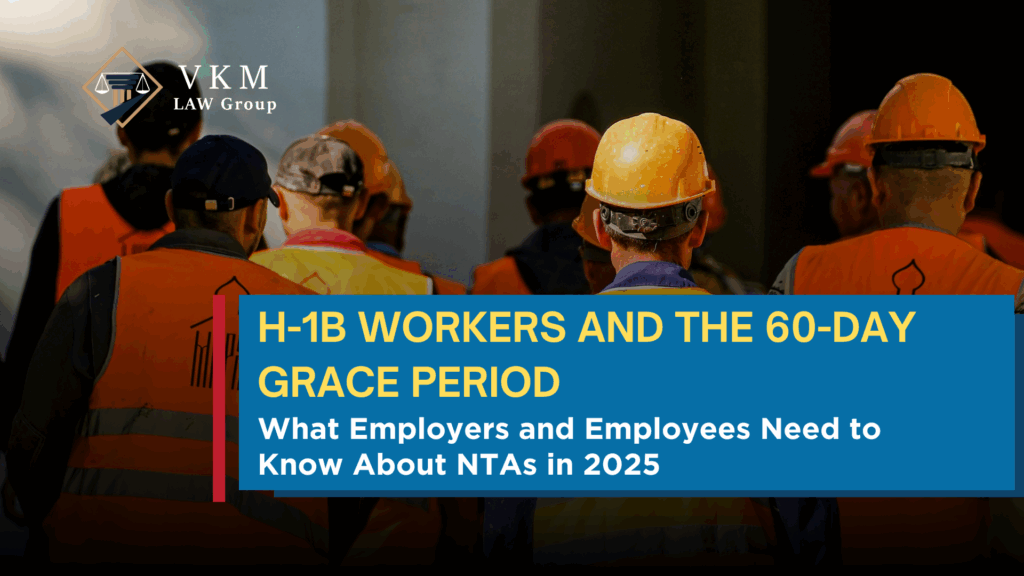
In a growing number of recent cases, U.S. Citizenship and Immigration Services (USCIS) has issued Notices to Appear (NTAs) in removal proceedings to H-1B workers—even when they had valid and timely-filed change of employer (COE) or change of status (COS) applications within the 60-day grace period following termination of employment.
This marks a significant policy shift and raises questions about the security of the grace period, once considered a crucial protection for high-skilled foreign nationals.
What Is the 60-Day Grace Period?
Under 8 CFR § 214.1(l)(2), foreign nationals in certain nonimmigrant visa categories—including H-1B, H-1B1, E-3, L-1, O-1, and TN—are granted a discretionary 60-day grace period after termination of employment. During this time, they can:
- File a Change of Employer petition
- Apply for a Change of Status
- Prepare for departure
- Explore other lawful status options
However, this grace period is not guaranteed, it is discretionary, and recent trends suggest that discretion is now being exercised more narrowly.
Key Development: NTAs During the Grace Period
Beginning in early 2025, immigration practitioners have reported a troubling trend: USCIS issuing NTAs to H-1B workers who:
✅ Were terminated
✅ Filed a COE or COS application within the 60-day window
❌ Still received NTAs after their former employer withdrew their H-1B petition
This appears to reflect increased alignment between USCIS and Immigration and Customs Enforcement (ICE), which views these individuals as no longer in lawful status, despite timely filings.
Legal and Policy Framework
Here’s what the law and policy actually say:
✅ Regulation – 8 CFR § 214.1(l)(2):
- The 60-day grace period prevents an individual from being considered “out of status” solely due to job loss.
- But DHS can shorten or eliminate the grace period at its discretion.
✅ USCIS Policy Manual:
- Discretion should be applied fairly and consistently.
- Favorable discretion should be granted absent adverse factors.
- The original intent was to facilitate job portability for high-skilled workers.
February 2025 NTA Policy Memo: What Changed?
On February 28, 2025, USCIS issued a revised NTA Memo, instructing adjudicators to issue NTAs if:
- A petition is denied, and
- The applicant is no longer in lawful status, even briefly, and
- The individual is otherwise removable
This policy applies even to timely and non-frivolous filings, significantly increasing the risks associated with routine employment transitions.
Implications for H-1B Workers
1. Timely Filing No Longer Guarantees Safety
Even with a timely COE or COS filing within the grace period, there’s no assurance of protection from an NTA.
2. Discretion is Key
USCIS adjudicators may deny discretion and issue NTAs, especially where any adverse factors exist (fraud, unauthorized work, criminal issues).
3. USCIS Website Changes
The former “Options for Nonimmigrant Workers” page has been archived, indicating a shift away from promoting grace-period protections.
Employer Obligations Under the Law
Employers are strictly liable for complying with termination procedures when ending the employment of an H-1B, H-1B1, or E-3 worker.
✅ To effectuate a bona fide termination, employers must:
- Notify the employee of termination
- Inform USCIS (for H-1B, H-1B1, E-3 cases with petitions)
- Offer or pay return transportation
Failure to meet all three requirements may result in:
- Wage liabilities
- LCA violations
- Backpay awards (e.g., $30,000+ in DOL cases)
Employers cannot delay termination procedures until the grace period ends.
Practice Tips for Immigration Attorneys and Employers
For immigration practitioners and employers, this evolving policy landscape calls for heightened diligence:
✅ Attorneys Should:
- File petitions early within the grace period (ideally with premium processing)
- Include cover letters requesting favorable discretion
- Provide supporting evidence of bona fides (job offer, employment contract, etc.)
- Discuss fallback strategies, such as filing a B-2 “bridge” application
- Include NTA and grace period disclaimers in client retainer agreements
✅ Employers Should:
- Ensure proper H-1B termination steps are taken immediately
- Avoid assuming the 60-day grace period allows delayed notification to USCIS
- Consider liability risks under DOL Wage & Hour Division enforcement
Conclusion: What It Means for the Future
The 60-day grace period is not a blanket protection. The combination of the February 2025 NTA Memo and strict employer compliance rules places both employers and H-1B workers at greater risk of triggering removal proceedings even when everyone acts in good faith.
At VKM Law Group we strongly advise clients to approach the 60-day window with strategic legal guidance and urgency.
Need Guidance?
Whether you’re an employer looking to ensure LCA compliance or a foreign worker navigating H-1B changes, VKM Law Group can help you stay compliant and protected.
📍 Serving clients throughout New Jersey and nationwide.
📞 Contact us today to schedule a strategy session with an experienced immigration attorney in New Jersey.